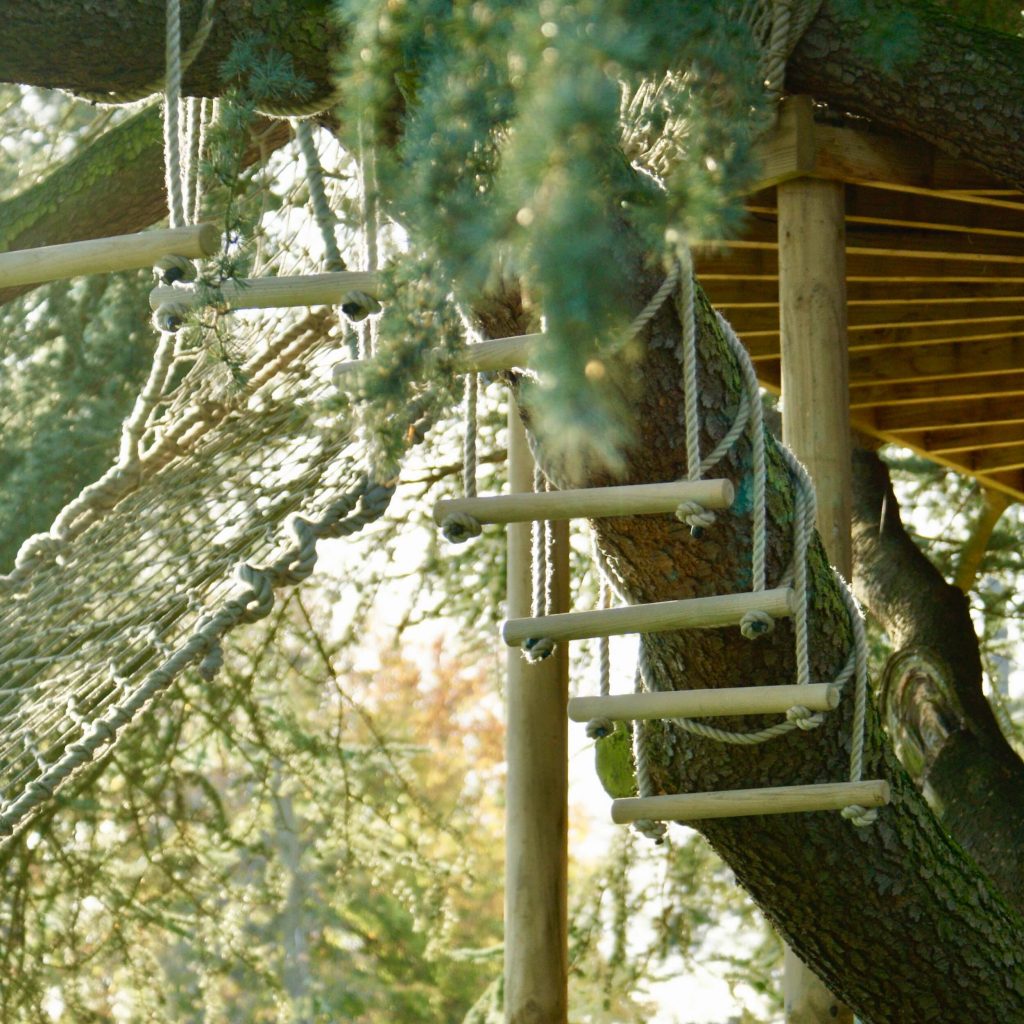“Another kind of high rise” – Financial Times – Simon Busch
“Nobody needs one.” This is a peculiar thing for a treehouse builder to say about treehouses. But that is exactly what Paul Cameron tells me as he and his team at Treehouse Life put the finishing touches on their latest project, a multi-decked construction spiralling around a thick old blue cedar in the sweeping grounds of a property in Surrey, south-east England. “They are pure whim,” he adds, “an emotional space.”
It is a point made powerfully, I remember, in the Ian McEwan novel A Child in Time, in which a male character spends an increasing amount of time playing childish games on a tree platform he has built in a nearby wood. He is regressing as literally as he can until, one day, falling from the tree, he regresses all the way.
Yet you cannot, Cameron says, “just stick a house in a tree and expect kids to have fun”. Treehouses have transcended the elevated-shed stage and his clients now want to explore their full scope as outside spaces for adults and children.
Take the design for the Surrey property, which spills beyond the multiple, twisting platforms – what he calls his signature style – of the treehouse itself to a “secret entrance” (assuming a child’s somewhat myopic conception of secrecy) starting in a vaulting natural hollow in a hedge and continuing, via a stone-clad climbing tower, along a rope bridge. There is also a vaguely African-looking thatched roof and more traditional childish accoutrements such as a slide. But he has also incorporated a garden location to make the most of the evening light, decks that will comfortably accommodate drinks after work and pinpoint LEDs to keep things softly in sight once the sun has set and the children have been sent to bed.

Treehouse options have proliferated to such an extent that companies such as Cameron’s now present clients with computer-drawn, three-dimensional models of potential designs, wrapped around their chosen trees, long before a saw is taken to wood. Increasingly, the brief is to include all the trappings of conventional houses.
Simon Payne, who with his brother Andy runs Blue Forest – the pair were inspired to set up the company by the wooden safari houses throughout Kenya, where they grew up – says customers increasingly demand treehouses kitted out with double glazing, insulation, electricity, broadband and plumbing. These are adult refuges from children, rather than the other way around.
One of the brothers’ recent projects, for a client in Greece, exploited the technological development of the treehouse to its fullest advantage. The Hi-tech Hideaway includes, along with a kitchenette and ample living space, fingerprint-scanning locks, a CCTV “control centre” with screens linked to night-vision cameras, digital photo frames throughout and every video game appurtenance imaginable.
“The treehouse fully grown up…”
At first sight, such a complex might resemble the treehouse fully grown up; on second inspection it is clearly only a boy’s fantasy electrified. But there are more mature and attractive architecturally designed shelters in Alejandro Bahamón’s Treehouses: Living a Dream, just published in paperback; the Germans seem particularly adept at making treehouses that merge organically with the tree, without sacrificing comfort.
The book also imagines virtual, yet plausible, treehouses. One, by the architecture practice Softroom, conceived in response to a design challenge set by Wallpaper magazine, proposes a lightweight, sinuous structure of steel, plastic and elastic, comprising all the basic elements of a house and easily attached to a tree without damaging it. Even more portable is the proposed Lifepod, a pill-shaped, moulded plywood tree cabin suspended high in the air between tree trunks by thick stainless steel cables.


No other building, Bahamón points out, has “such a close relationship with its surroundings as a treehouse. From the election of the site to the construction details, its design is closely tied to the characteristics of the tree chosen to harbour [it].” The use of living foundations, constantly growing and moving with the wind, has, Bahamón argues, “generated a variety of treehouses as rich as that of the trees on the planet”.
That observation points to a controversy within the treehouse world: that between “true” treehouses and those that rely on the ground for support. “True” treehouses are held aloft entirely (or almost entirely) by a tree or trees and their proponents would say they best embody the symbiotic spirit Bahamón describes. They certainly tend towards the idiosyncratic. Patrick Fulton documents some in his online Treehouse Guide, featuring often ramshackle, amateur structures incorporating scavenged windows and wood and yet with impressively elaborate layouts despite their frighteningly high perches.
Cameron’s Surrey treehouse is of the supported kind; it embraces the trunk and branches of the tree but is stabilised by posts on the ground. Such less vertiginous structures not only make plummeting ends of the kind Ian McEwan imagines less likely, they also, Cameron says, duck under planning laws and cause less harm to the trees.
“Treehouses are intrinsically environmentally friendly…”
Indeed, treehouse builders report numerous inquiries recently from people attracted to the low environmental impact of tree dwellings. “Treehouses are intrinsically environmentally friendly because they don’t involve clearing vegetation,” Simon Payne says. “They’re not like traditional houses, where you clear a plot, re-landscape and put in significant foundations; they’re structures you put in around the existing landscape.”
Stuart Hadwin, of The Treehouse Company, describes a shift in customer enquiries from wealthy adventure-seekers towards environmentally concerned types who see treehouses as “residential solutions full stop. It is only a matter of time before someone designs them as residential accommodation,” he adds.
That is Cameron’s dream: to shift his family full-time to a treehouse in Cornwall. More of us may soon be living (once again) in the trees.
Another Kind of High Rise – Simon Busch – Financial Times
Ascot Awards Berkshire Castle Christmas Present Client Commercial Client Cotswolds Côte d'Azur Daily Mail Dominican Republic Essex Financial Times Glamping Hampshire India Italy Jersey Kent Lancashire London Monaco National Trust Northampton Northumberland Paul Cameron Portugal Press Feature Preston Private Client Private Land & Estates Quebec Resort Rope Bridges School Scotland Seychelles Society Magazine Somerset Suffolk Sunningdale Surrey Surrey Life Sussex Testimonial The Independent The Sun The Telegraph Treehouse UK Visitor Attraction Yorkshire




